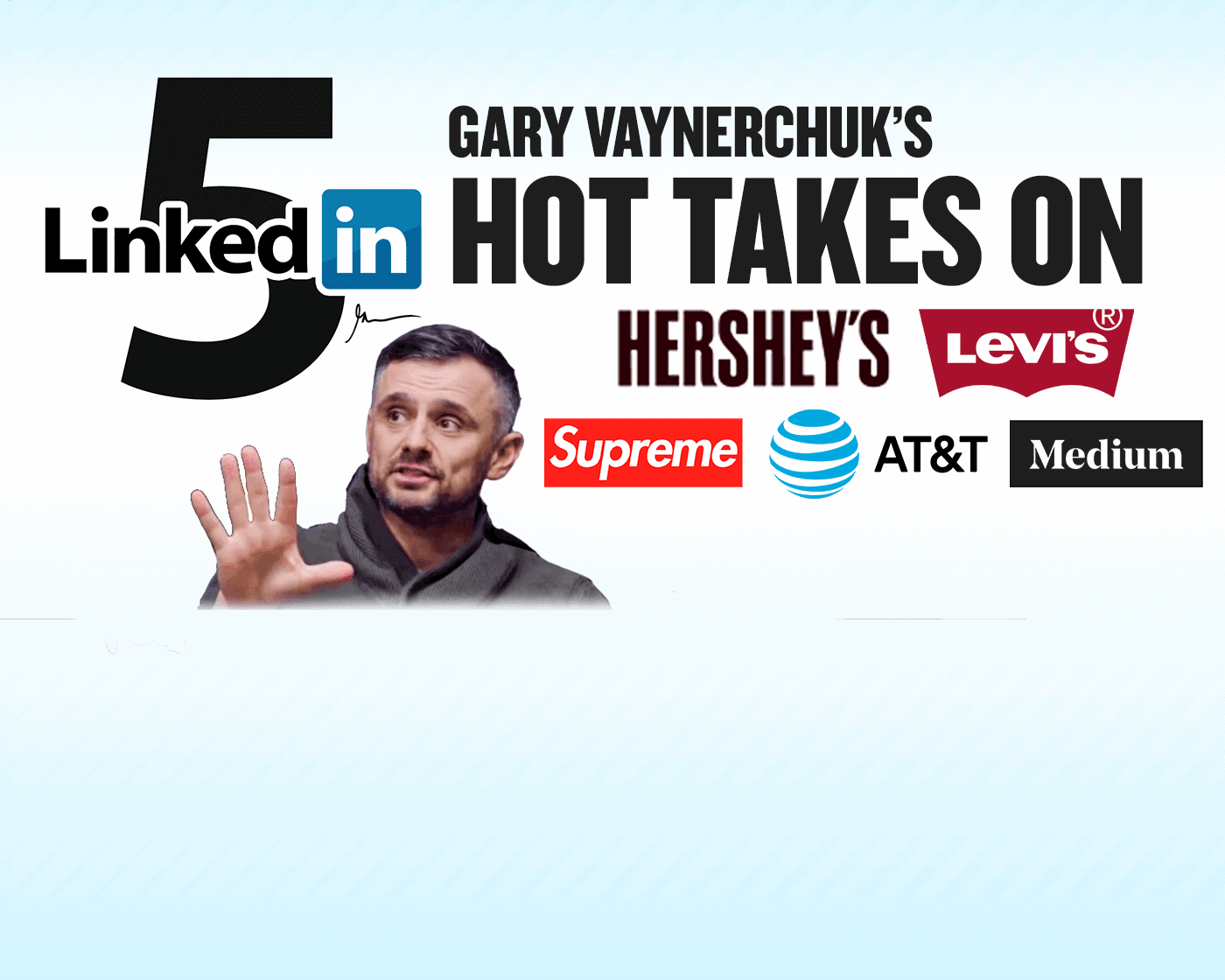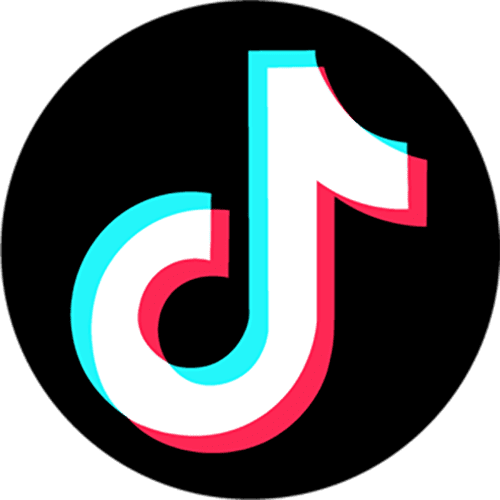Hope you enjoy the second edition of “LinkedIn 5” !!
For those of you who missed the last one … a while ago, I came up with this new content format:
“LinkedIn 5” will be a bunch of quick, deep business hot-takes on what I see in the corporate world, marketing opportunities, new product categories that companies can get into, and more. Not saying I’m 100% “right” about everything I share – just passionate about sharing my POVs and perspectives. Hope you guys like it and get value from it!
In this one I talk about some opportunities and points of views on Hershey’s, Levi’s, Supreme, AT&T, and Medium –
Hershey’s could get into meaningful chocolate extensions
A few couple of thoughts on Hershey’s…
When you hear Hershey’s you hear chocolate.
So whether it’s direct to consumer chocolate shakes, protein shakes, smoothies, or other products, I would focus on line extensions where their chocolate-focused brand has “permission” to go. I also would probably create a super premium chocolate bar like a ~$25-$30 Hershey’s bar that elevates the brand, which could create sales and also make their core products feel like a good deal in comparison.
Could Levi’s create smart pants?
What I think Levi’s should consider, as an iconic brand with denim, is to be a pioneer on what’s next.
Levi’s feels like the brand that can really win the first “smart pants” game. I believe that the things we wear will eventually get “smart” – in other words, your pants will one day connect to your phone and tell you that you need to lose weight as they start to get tighter (for example). Your pants will be able to “talk” to you (some athletic wear brands already do this). As things like IoT and voice get more and more traction, I think that’s going that route will be a real business, and it’s Levi’s for the taking.
My hot take on Supreme
I think Supreme has achieved a level of status as a cool brand, but in my opinion they need to be a little careful to not extend its brand too much.
It’s funny – with Hershey’s, I want them to extend it. With Supreme, I want them to be thoughtful about where they extend it. When a brand starts doing a ton of JVs with other brands, it can create a vulnerability that can lead to saturation.
They’re a big business and so I have a lot of empathy for that, but in one man’s opinion, I would tighten that brand up and be thoughtful about where it’s extending. When you think about other brands that extend their brand to everything, it eventually gets to a point where it means nothing. I think Supreme did an incredible job of building and achieving that “cool” status in culture, and now they need to be very thoughtful to not overextend their brand to places that could potentially be create a decline in that status.
It’s less about “where” they should stick to – it’s just about being super thoughtful going forward about who they decide to do JVs with.
The positioning of AT&T’s HBO Max as more “family friendly” makes sense
AT&T’s really a media company at a scale at this point – it’s a media conglomerate.
I think they need to find the best IP in the world and attach that to their distribution products, so I’m a little less versed in what I would actually do there – other than understanding the importance of IP. For example, looking at when Fox got The Simpsons, when they got NFL games, or realizing how important it is to have another “House of Cards”, etc. Networks are built a lot of times on IP. OTTs are now networks in theory, and doing a lot of thinking around what content they’re going to fill their pipes is important – hence why they did the Turner deal. But I think it needs to extend even further now they need franchises.
The positioning of the upcoming HBO Max to be more family friendly makes a ton of sense, in a world of competing with things like Disney Plus. We think about HBO we think high quality, more adult – and I think the HBO brand much like Hershey’s has a lot of opportunity to go and expand its wings.
I believe in Medium’s pay-for-content strategy
I should disclose first that I was an early investor in Medium.
They’ve gone with the “pay for content” model, which I’m a supporter of. I’ve found myself in the last 12 months clicking articles that I find on social, and then feel the desire to read them even though they’re behind paywalls. I haven’t paid for one yet, but last week there was an article that I really wanted to read, and I was close to paying. I thought that was an interesting chemical feeling that I was close to signing up for $9 / month, even though I didn’t have interest at that moment to read any other articles on that site.
I think Medium has that potential for sure – original, creative content would really play. Think of Medium like Sirius. If they get some original writers that only live in that environment, their subscription product can get really good. It comes down to casting.
I talk about putting out content for free but I also think anybody can charge for content if they’re good enough. However most people aren’t good enough from the start, which is why it can help to put free content and build leverage. For example – last time I checked, nobody on earth would pay to come watch me play basketball. Right? But there’s an entire league where people would. That’s how I think about content – a percentage of content creators today are not good enough to charge for their content directly, AKA the market doesn’t enjoy their content enough to pay for it.
But some are good enough, and I think there’s big business there in written / audio / video form and I think you’ll see that continue to play out over the next decade.












pin up aviator: pin up giris – pin up casino guncel giris
https://pinupturkey.pro/# pin-up casino
пин ап казино вход https://pinupkz.tech/# pin up kz
пин ап
pin up казино: пин ап казино зеркало – pin up
пинап казино http://pinupkz.tech/# пинап кз
pin up казино
pin up казино: pin up – pin up казино
zithromax 250 mg: zithromax for sale – zithromax azithromycin
drug neurontin 20 mg neurontin 800 mg tablets best price gabapentin 600 mg
https://amoxil.llc/# amoxicillin 500mg capsules
can you buy zithromax over the counter in canada
https://gabapentin.auction/# neurontin 100mg
https://gabapentin.auction/# neurontin 100mg discount
minocin 50 mg for scabies: stromectol for humans – ivermectin lice oral
over the counter amoxicillin canada buy amoxil amoxicillin for sale
https://amoxil.llc/# can you buy amoxicillin uk
http://amoxil.llc/# cost of amoxicillin
can you buy zithromax over the counter in canada
https://gabapentin.auction/# neurontin 50mg tablets
https://gabapentin.auction/# gabapentin 300mg
Rybelsus 14 mg Buy compounded semaglutide online rybelsus price
Rybelsus 14 mg price: Rybelsus 14 mg – Buy semaglutide pills
https://gabapentin.auction/# neurontin 600 mg price
https://gabapentin.auction/# neurontin buy online
cost of generic zithromax
800mg neurontin buy gabapentin neurontin 900
minocycline 50mg without doctor: stromectol pill for humans – order minocycline 50mg online
https://stromectol.agency/# stromectol 3 mg price
http://gabapentin.auction/# neurontin 100mg cost
zithromax 500 tablet
can you buy zithromax over the counter in mexico order zithromax zithromax for sale online
http://semaglutide.win/# semaglutide
ivermectin cream uk: cheapest stromectol – ivermectin online
https://stromectol.agency/# ivermectin 6 mg tablets
http://semaglutide.win/# cheap Rybelsus 14 mg
https://stromectol.agency/# ivermectin price uk
zithromax over the counter
amoxicillin price without insurance amoxicillin 500mg capsules uk amoxicillin from canada
cost of neurontin 600 mg: gabapentin price – buy neurontin online uk
http://stromectol.agency/# ivermectin over the counter canada
zithromax buy
order amoxicillin 500mg cheapest amoxil amoxicillin cost australia
minocycline pills: cheapest stromectol – ivermectin cream 1
http://semaglutide.win/# rybelsus generic
https://zithromax.company/# zithromax purchase online
zithromax antibiotic
zithromax canadian pharmacy zithromax for sale how to get zithromax over the counter
https://stromectol.agency/# what does minocycline treat
amoxicillin 500mg capsule: amoxicillin cheapest price – amoxicillin 500mg capsule buy online
http://zithromax.company/# zithromax for sale us
Rybelsus 14 mg price semaglutide order Rybelsus for weight loss
https://semaglutide.win/# cheap Rybelsus 14 mg
zithromax buy online
https://amoxil.llc/# generic amoxicillin cost
buy semaglutide online: rybelsus price – Buy semaglutide pills
https://zithromax.company/# zithromax prescription in canada
zithromax 500 mg lowest price online
buying neurontin without a prescription: gabapentin price – medicine neurontin 300 mg
amoxicillin medicine over the counter amoxil best price amoxicillin without a doctors prescription
https://semaglutide.win/# order Rybelsus for weight loss
where can i buy zithromax uk
ivermectin 3mg tab: cheapest stromectol – ivermectin 0.5%
where can i buy amoxicillin online amoxicillin cheapest price amoxil pharmacy
https://semaglutide.win/# buy semaglutide online
zithromax 250mg
buy minocycline 100 mg tablets: stromectol best price – buy ivermectin
ivermectin usa price stromectol best price stromectol online canada
https://stromectol.agency/# stromectol tablets uk
zithromax online usa no prescription
indian pharmacy: pharmacy website india – online shopping pharmacy india
https://indianpharmdelivery.com/# indian pharmacy
india pharmacy
indian pharmacies safe: mail order pharmacy india – Online medicine home delivery
pharmacy website india top online pharmacy india reputable indian online pharmacy
ed meds http://mexicanpharm24.pro/# mexico drug stores pharmacies
п»їlegitimate online pharmacies india: india online pharmacy – cheapest online pharmacy india
india online pharmacy: pharmacy website india – indianpharmacy com
ed meds online pharmacy erection pills viagra online ed medicine online
ed products http://indianpharmdelivery.com/# world pharmacy india
http://drugs24.pro/# cheap erectile dysfunction pill
indianpharmacy com
reputable indian pharmacies: Online medicine order – indianpharmacy com
medication from mexico pharmacy buying prescription drugs in mexico mexico drug stores pharmacies
world pharmacy india: online pharmacy india – Online medicine home delivery
top ed drugs http://mexicanpharm24.pro/# purple pharmacy mexico price list
http://indianpharmdelivery.com/# top online pharmacy india
world pharmacy india
mexico drug stores pharmacies: medication from mexico pharmacy – mexican online pharmacies prescription drugs
viagra without a doctor prescription: ed pills online pharmacy – ed medicine online
mexico pharmacies prescription drugs mexican online pharmacies prescription drugs buying prescription drugs in mexico online
https://indianpharmdelivery.com/# pharmacy website india
indian pharmacy paypal
ed pills that really work https://drugs24.pro/# ed treatments that really work
п»їlegitimate online pharmacies india: reputable indian online pharmacy – reputable indian pharmacies
Online medicine home delivery: п»їlegitimate online pharmacies india – Online medicine home delivery
mail order pharmacy india online shopping pharmacy india online shopping pharmacy india
generic ed pills http://indianpharmdelivery.com/# best online pharmacy india
https://indianpharmdelivery.com/# mail order pharmacy india
india pharmacy
best male enhancement ed pills cheap ed aids
ed vacuum pumps http://mexicanpharm24.pro/# reputable mexican pharmacies online
buy prescription drugs from india indian pharmacy online online pharmacy india
https://drugs24.pro/# ed in young men
cheapest online pharmacy india
https://rybelsus.icu/# rybelsus.icu
ed medications
paxlovid pharmacy shop buy paxlovid online
stromectol 3mg: stromectol fast delivery – minocycline 50
https://stromectol1st.shop/# buy minocycline 100mg otc
indianpharmacy com
rybelsus.icu: Semaglutide pharmacy price – good price
http://rybelsus.icu/# order Rybelsus
pump for ed
buy rybelsus: buy rybelsus – rybelsus generic
https://stromectol1st.shop/# ivermectin 8 mg
drugs that cause ed
ivermectin 90 mg stromectol 1st stromectol medicine
generic ivermectin cream: stromectol uk buy – ivermectin 4000 mcg
https://stromectol1st.shop/# ivermectin nz
buy prescription drugs without doctor
more rybelsus generic good price
buy clopidogrel bisulfate: here – buy Clopidogrel over the counter
Plavix 75 mg price: here – Plavix generic price
http://stromectol1st.shop/# what is minocycline used for
indian pharmacy paypal
http://clopidogrel.pro/# Plavix 75 mg price
drug medication
п»їplavix generic clopidogrel pro Cost of Plavix on Medicare
what is minocycline: stromectol shop – stromectol tablets for humans
Cost of Plavix without insurance: generic pills – buy Clopidogrel over the counter
https://paxlovid1st.shop/# paxlovid pharmacy
mens erection pills
Plavix generic price clopidogrel pro buy plavix
http://stromectol1st.shop/# minocycline 50mg tablets
top 10 pharmacies in india
antiplatelet drug: clopidogrel pills – buy Clopidogrel over the counter
http://stromectol1st.shop/# minocycline cost
ed vacuum pumps
buy paxlovid online: buy paxlovid online – paxlovid cost without insurance
paxlovid generic buy here paxlovid covid
http://stromectol1st.shop/# ivermectin 3 mg tabs
top 10 online pharmacy in india
rybelsus cost: rybelsus – semaglutide
buy rybelsus: rybelsus – rybelsus cost
cheaper rybelsus generic rybelsus price
ivermectin for humans: stromectol fast delivery – order minocycline 50mg online
clopidogrel bisulfate 75 mg: check clopidogrel pro – plavix best price
http://stromectol1st.shop/# ivermectin 500ml
top 10 online pharmacy in india
Paxlovid buy online paxlovid price Paxlovid over the counter
cheaper: semaglutide – rybelsus price
minocycline 50 mg without prescription: stromectol 1st – stromectol online
buy clopidogrel bisulfate generic plavix clopidogrel bisulfate 75 mg
http://stromectol1st.shop/# minocycline for rosacea
Online medicine order
ivermectin price: ivermectin pills canada – stromectol 0.5 mg
ivermectin generic name: stromectol fast delivery – ivermectin stromectol
buy rybelsus rybelsus price buy rybelsus
pinup az pin up pin-up
пин ап зеркало: пин ап – пинап зеркало
https://1wintr.fun/# canl? casino siteleri
пин ап кз
casino sitesi: casino oyunlar? – cazino
http://1winrussia.online/# 1xbet официальный сайт
пинап кз
1хставка: 1xbet – 1хбет
пин ап зеркало: пин ап зеркало – пин ап зеркало
en iyi casino siteleri: h?zl? casino – casino sitesi
slot casino siteleri slot casino siteleri guvenilir casino siteleri
h?zl? casino: casino oyunlar? – slot casino siteleri
http://1wintr.fun/# h?zl? casino
пин ап
пин ап официальный сайт: пин ап – пин ап зеркало
pin-up casino giris pin up casino pin-up casino giris
pin up casino: pin-up – pin-up
pin up: pin up 306 – pin up azerbaycan
https://1winrussia.online/# 1хбет
пин ап казино
1xbet зеркало: 1xbet официальный сайт – 1xbet
dunyan?n en iyi casino siteleri: canl? casino siteleri – canl? casino
пин ап: пин ап зеркало – пин ап официальный сайт
http://1wintr.fun/# canl? casino
пинап казино
best otc ed pills: online ed medications – solutions for ed
mexican online pharmacies prescription drugs pharmacies in mexico that ship to usa mexico drug stores pharmacies
п»їbest mexican online pharmacies: mexico drug stores pharmacies – purple pharmacy mexico price list
ed medications discount prescription drugs buy online drugs
erection pills: erectile dysfunction medicines – herbal remedies for ed
top 10 online pharmacy in india: Online medicine order – india pharmacy mail order
medication from mexico pharmacy: п»їbest mexican online pharmacies – mexican pharmaceuticals online
world pharmacy india top online pharmacy india mail order pharmacy india
india online pharmacy: best online pharmacy india – top 10 online pharmacy in india
mexico drug stores pharmacies mexican drugstore online medicine in mexico pharmacies
ed in men: buying ed pills online – ed help
sweetbonanzatrpro: sweet bonanza – sweet bonanza tr
pin up pinup az pinup az
Пин Ап Казино Официальный Сайт в России: пинап казино – пинап казино
sweetbonanzatr.pro sweet bonanza sweetbonanzatrpro
sweetbonanzatrpro: sweetbonanzatrpro – sweet bonanza
https://pinup-az.bid/# pin up 306
pinup bet and casino
pin up azerbaycan: pin up casino – pin-up
sweet bonanza: sweetbonanzatr.pro – sweet bonanza oyna
sweet bonanza tr sweet bonanza sweet bonanza tr
sweetbonanzatrpro: sweet bonanza tr – sweet bonanza
sweet bonanza nas?l oynan?r sweet bonanza oyna sweet bonanza
http://pinup-az.bid/# pin up azerbaycan
pin up zerkalo
пин ап казино: пин ап 634 – пин ап 634
пин ап зеркало: пин ап казино – пинко
пин ап казино онлайн: пины – pin up kz
пин ап кз пин ап казино Пин Ап Казино Официальный Сайт
pin-up casino giris: pinup – pinup
pinco: пинап казино – пин ап вход
top-rated pills: buy amoxil online – top-rated pills
https://stromectol1st.store/# stromectol best price
Care provides: Care provides – involves multisystem
https://paxlovid1st.store/# see a healthcare provider
see a healthcare provider: paxlovid store – See risks
https://semaglutide.ink/# Urgent Specialists
paxlovid store: paxlovid store – See risks
buying prescription drugs in mexico online: mexico pharmacy cheap – mexico pharmacies prescription drugs
reputable indian online pharmacy: indian pharmacy purchase online – pharmacy website india
pharmacy website india: India pharmacy international – pharmacy website india
purple pharmacy mexico price list: Mexican pharmacy ship US – mexico pharmacies prescription drugs
purple pharmacy mexico price list: mexican pharmacy – mexican online pharmacies prescription drugs
reputable indian online pharmacy: indian pharmacy purchase online – top 10 online pharmacy in india
best ed treatment: cheap meds – prescription drugs online without doctor
https://pharm24.pro/# buy prescription drugs online legally
viagra without doctor prescription
mexican drugstore online: mexico pharmacy – mexico drug stores pharmacies
mexican border pharmacies shipping to usa: mexican pharm 24 – mexican mail order pharmacies
dog antibiotics without vet prescription: cheap pharmacy – herbal ed
https://mexicanpharm24.cheap/# mexico drug stores pharmacies
medication drugs
tadalafil without a doctor’s prescription: cheap pharmacy online – ed tablets
mexican pharmaceuticals online: Legit online Mexican pharmacy – purple pharmacy mexico price list
https://pharm24.pro/# how to get prescription drugs without doctor
best medicine for ed
ultrabet yeni giris 1125: ultrabet tr online – ultrabet guncel
Deneme Bonusu Veren Siteler: Casino Siteleri – Casino Siteleri
ultrabet: ultrabet tr online – ultrabet guncel
ultrabet guncel ultrabet giris ultrabet guncel
slot tr online: en cok kazand?ran slot oyunlar? – slot oyunlar? puf noktalar?
slot tr online: slot oyunlar? puf noktalar? – slot siteleri
deneme bonusu veren yeni siteler https://ultrabet-tr.online/# ultrabet guncel
Casino Siteleri: Canl? Casino Siteleri – Canl? Casino Siteleri
Casino Siteleri: Casino Siteleri – casino siteleri win
http://denemebonusuverensiteler.top/# deneme bonusu veren siteler
deneme bonusu veren siteler yeni
deneme bonusu veren siteler yeni https://casinositeleri.win/# guvenilir casino siteleri
en cok kazand?ran slot oyunlar?: en cok kazand?ran slot oyunlar? – az parayla cok kazandiran slot oyunlar?
deneme bonusu veren siteler yeni: deneme bonusu veren siteler 2024 – deneme bonusu veren siteler yeni
matadorbet giris: matadorbet.bid – matadorbet giris
az parayla cok kazandiran slot oyunlar?: slot oyunlar? puf noktalar? – slot tr online
deneme bonusu veren siteler betturkey: denemebonusuverensiteler.top – deneme bonusu veren siteler denemebonusu2026.com
buy gabapentin: GabaPharm Gabapentin – cheapest Gabapentin GabaPharm
https://erepharm.com/# ED meds online
http://furpharm.com/# furosemide
GabaPharm Gabapentin: gabapentin – GabaPharm Gabapentin
http://rybpharm.com/# semaglutide
lasix: furosemide – buy furosemide online
http://furpharm.com/# lasix
rybpharm: semaglutide – rybpharm rybelsus
http://erepharm.com/# cheapest ed pills ere pharm
buy kamagra oral jelly Kam Pharm: kampharm.shop – kampharm.shop
https://furpharm.com/# furosemide fur pharm
http://furpharm.com/# fur pharm
ED meds online with insurance: best ed pills online – best ed pills online
kam pharm shop: kamagra – Kam Pharm
https://furpharm.com/# lasix
buy rybelsus rybpharm buy rybelsus rybpharm cheap semaglutide
https://furpharm.com/# lasix
https://furpharm.com/# fur pharm
Kamagra Kam Pharm buy kamagra oral jelly Kam Pharm kam pharm shop
http://rybpharm.com/# rybpharm rybelsus
kampharm.shop: buy kamagra oral jelly Kam Pharm – kamagra
Kam Pharm: cheapest Kamagra Kam Pharm – cheapest Kamagra Kam Pharm
https://erepharm.com/# erepharm.com
https://canadiandrugsgate.com/# ambien without a doctor’s prescription
buy medicines online in india: Indian pharmacy international shipping – best online pharmacy india
https://mexicanpharmgate.com/# mexico pharmacies prescription drugs
buying from online mexican pharmacy: mexican pharmacy online medications – mexican online pharmacies prescription drugs
https://canadiandrugsgate.com/# treatment for erectile dysfunction
mexican online pharmacies prescription drugs mexican pharmacy buying from online mexican pharmacy
http://indianpharmacyeasy.com/# buy medicines online in india
http://mexicanpharmgate.com/# medicine in mexico pharmacies
mexican drugstore online: mexicanpharmgate.com – mexican online pharmacies prescription drugs
http://mexicanpharmgate.com/# buying prescription drugs in mexico
mexican mail order pharmacies: mexican pharmacy online medications – mexican online pharmacies prescription drugs
mexican drugstore online mexican pharmacy mexico pharmacies prescription drugs
pharmacies in mexico that ship to usa: Mexican Pharmacy Gate – buying prescription drugs in mexico
http://indianpharmacyeasy.com/# pharmacy website india
how to get prescription drugs without doctor: Canadian pharmacy online – ed in men
best india pharmacy: indian pharmacy easy – india pharmacy
https://canadiandrugsgate.com/# buy medication online
best canadian pharmacy online canadiandrugsgate best natural ed treatment
buy medicines online in india: indianpharmacyeasy.com – india pharmacy
https://mexicanpharmgate.com/# mexico pharmacies prescription drugs
mexico pharmacies prescription drugs: mexicanpharmgate.com – buying prescription drugs in mexico
mail order pharmacy india Best Indian pharmacy buy prescription drugs from india
ed pills: canadiandrugsgate.com – cheap erectile dysfunction pills
cheap priligy: dapoxetine online – priligy
buy generic prednisone online: buy prednisone – prednisone 1 mg tablet
Priligy tablets priligy maxpharm priligy maxpharm
where to buy amoxicillin http://prednisoneraypharm.com/# where can i buy prednisone without a prescription
dapoxetine online: max pharm – dapoxetine online
where can i get amoxicillin 500 mg: amoxil – amoxil generic
priligy max pharm cheap priligy buy dapoxetine online
order amoxicillin online http://amoxilcompharm.com/# amoxicillin 500 mg
buy priligy max pharm: cheap priligy – buy priligy
get cheap clomid without rx: rexpharm – can you get cheap clomid without insurance
cost of amoxicillin 30 capsules Com Pharm amoxacillian without a percription
amoxicillin capsules 250mg https://amoxilcompharm.com/# amoxicillin 875 125 mg tab
amoxicillin 800 mg price: buy amoxil online – buy cheap amoxicillin
where can i get cheap clomid pill: can i buy generic clomid without insurance – how to get generic clomid without a prescription
where to get cheap clomid prices clomid online can you get cheap clomid
buy priligy: buy dapoxetine online – buy dapoxetine online
buying cheap clomid online: clomid – can you get generic clomid pills
amoxicillin pharmacy price: Amoxicillin buy online – where can i buy amoxicillin online
buy prednisone 20mg without a prescription best price: order Prednisone – prednisone 20 tablet
cost generic clomid now: rex pharm – how can i get cheap clomid no prescription
purchase amoxicillin online without prescription: buy amoxil online – amoxicillin online no prescription
buy dapoxetine online: buy priligy – dapoxetine online
order prednisone from canada: prednisone 60 mg price – prednisone prescription online
mexican online pharmacies prescription drugs https://mexicanpharmgate.com/ medication from mexico pharmacy
buy Lisinopril 1st: lisinopril online prescription – lisinopril 10mg
dapoxetine online: buy dapoxetine online – buy priligy max pharm
http://plavixclo.com/# Cost of Plavix on Medicare
clopidogrel bisulfate 75 mg: Plavix Clo – Plavix 75 mg price
amoxicillin 500mg capsule buy online: amoxil com pharm – where to buy amoxicillin 500mg
clopidogrel bisulfate 75 mg: PlavixClo Best Price – plavix medication
http://lisinopril1st.com/# lisinopril for sale online
over the counter prednisone cream: order Prednisone – prednisone 10 mg tablet
buy cytotec online: buy cytotec cytpremium – buy misoprostol over the counter
priligy maxpharm: priligy maxpharm – buy priligy
http://cytpremium.com/# buy misoprostol over the counter
plavix medication: PlavixClo – cheap plavix antiplatelet drug
steroids prednisone for sale: prednisone ray pharm – prednisone 20mg online
http://cytpremium.com/# п»їcytotec pills online
ivermectin 20 mg: buy Stromectol – ivermectin cream 1%
cheap priligy: buy priligy max pharm – priligy
пин ап казино официальный сайт: pinup kazi – pinup-kazi.ru
пин ап казино: пин ап казино онлайн – пин ап казино
pinup: пин ап казино – pinup kazi
пинап казино: пин ап казино онлайн – pinup-kazi.kz
пин ап казино официальный сайт: пин ап зеркало – pinup-kazi.ru
http://pinup-kazi.ru/# pinup
pin up казино пин ап казино онлайн pinup-kazi.kz
пин ап казино: pinup kazi – pin up казино
пинап казино: pinup kazi – пинап казино
казино вавада: вавада казино – вавада казино онлайн
pinup kazi: pinup – пин ап казино
pinup-kazi.kz: pinup-kazi.kz – pinup kazi
пин ап казино онлайн: пин ап казино онлайн – pinup
вавада казино зеркало: vavada kazi – vavada kazi
казино вавада: vavada – vavada-kazi.ru
пин ап казино: pinup-kazi.kz – pinup kazi
http://vavada-kazi.ru/# вавада казино
пин ап казино: пин ап казино официальный сайт – пинап казино
пин ап казино официальный сайт pinup kazi пин ап зеркало
pinup-kazi.ru: пин ап казино – пин ап казино
пин ап вход: пин ап вход – пин ап зеркало
best online pharmacy india: IndianPharmStar.com – buy medicines online in india
erectyle dysfunction canada pharmacy online erectile dysfunction natural remedies
natural ed medications: canadianpharm1st.com – cause of ed
buy prescription drugs without doctor: canadianpharm1st – buy ed drugs online
mexico drug stores pharmacies: MexicanPharmEasy – buying prescription drugs in mexico
impotence treatment https://indianpharmstar.com/# buy medicines online in india
best natural cure for ed: canadian pharmacy – ed meds online without doctor prescription
mexican rx online: mexican pharm easy – buying from online mexican pharmacy
mexico drug stores pharmacies mexican pharmacy mexican mail order pharmacies
pharmacies in mexico that ship to usa: mexicanpharmeasy.com – pharmacies in mexico that ship to usa
mexican pharmaceuticals online: Mexican Pharm – purple pharmacy mexico price list
mexican pharmaceuticals online mexican pharmacy purple pharmacy mexico price list
mexican drugstore online: MexicanPharmEasy – medication from mexico pharmacy
ed remedies: canadianpharm1st.com – legal to buy prescription drugs without prescription
ed medications online http://indianpharmstar.com/# top 10 online pharmacy in india
best india pharmacy: IndianPharmStar.com – top 10 online pharmacy in india
indian pharmacy paypal IndianPharmStar.com indian pharmacies safe
treat ed http://canadianpharm1st.com/# which ed drug is best
online shopping pharmacy india: IndianPharmStar – best india pharmacy
buy prescription drugs online legally: canadian pharm 1st – buy medications online
п»їbest mexican online pharmacies Pharm Easy buying from online mexican pharmacy
medicine in mexico pharmacies: mexican pharmacy – mexican mail order pharmacies
pills for ed: canadianpharm1st.com – new ed drugs
errectile disfunction: canadian pharm – best treatment for ed
indian pharmacy paypal IndianPharmStar.com buy prescription drugs from india
remedies for ed http://mexicanpharmeasy.com/# buying from online mexican pharmacy
mexican drugstore online: MexicanPharmEasy – mexican border pharmacies shipping to usa
top online pharmacy india: indian pharmacy – indian pharmacy
cure ed canadianpharm1st.com erectile dysfunction pills
natural treatment for ed: canadian pharm – new ed drugs
mexico drug stores pharmacies: MexicanPharmEasy – mexican mail order pharmacies
top 10 pharmacies in india: indian pharmacy – best india pharmacy
ed drugs online canadian pharmacy viagra vs cialis bodybuilding
Buy compounded semaglutide online: rybelsus cost – Buy semaglutide pills
amoxicillin order online no prescription: buy amoxicillin 500mg uk – Amoxil Pharm Store
Ivermectin Pharm ivermectin price canada Ivermectin Pharm
https://ivermectinpharm.store/# Ivermectin Pharm Store
Gabapentin Pharm: neurontin capsules 300mg – Gabapentin Pharm
Paxlovid.ink: Paxlovid.ink – Paxlovid.ink
http://amoxilpharm.store/# amoxicillin 500 coupon
ivermectin 400 mg: Ivermectin Pharm Store – Ivermectin Pharm Store
rybelsus cost: buy rybelsus – cheap Rybelsus 14 mg
Paxlovid.ink: Paxlovid.ink – Paxlovid.ink
http://gabapentinpharm.com/# Gabapentin Pharm
Gabapentin Pharm: neurontin capsules – neurontin 100mg tablet
Rybelsus 7mg: Semaglutide pharmacy price – rybelsus
buy rybelsus: semaglutide – buy rybelsus
over the counter neurontin Gabapentin Pharm Gabapentin Pharm
http://amoxilpharm.store/# Amoxil Pharm Store
paxlovid buy: paxlovid cost without insurance – Paxlovid.ink
rybelsus cost: Buy compounded semaglutide online – buy semaglutide online
https://semaglutidepharm.com/# rybelsus
п»їpaxlovid: paxlovid buy – paxlovid price
rybelsus: semaglutide pharm – buy semaglutide online
https://amoxilpharm.store/# AmoxilPharm
buy cytotec pills online cheap: Abortion pills online – buy cytotec pills
zithromax tablets: zithromax capsules australia – zithromax azithromycin
Abortion pills online buy misoprostol over the counter Abortion pills online
http://clomid.store/# where to get cheap clomid prices
zithromax coupon: buy generic zithromax online – buy zithromax 1000mg online
antibiotics cipro cipro for sale ciprofloxacin 500 mg tablet price
https://azithromycinus.com/# zithromax over the counter canada
Abortion pills online: buy cytotec online – Abortion pills online
http://azithromycinus.com/# zithromax 250 mg pill
how to get cheap clomid without rx: how to buy cheap clomid online – cost generic clomid without insurance
lisinopril 20g: can i order lisinopril online – lisinopril 40 mg discount
buy cipro cheap where can i buy cipro online cipro 500mg best prices
http://clomid.store/# how can i get clomid tablets
20 mg lisinopril without a prescription: no prescription lisinopril – lisinopril for sale online
can i buy generic clomid without a prescription: cost cheap clomid no prescription – how to get cheap clomid without rx
can i get clomid without prescription cost of generic clomid without insurance where can i buy cheap clomid no prescription
https://ciprofloxacin.cheap/# buy cipro online without prescription
buy cytotec over the counter: cytotec pills buy online – buy cytotec online fast delivery
ciprofloxacin over the counter buy generic ciprofloxacin ciprofloxacin 500mg buy online
https://ciprofloxacin.cheap/# antibiotics cipro
zithromax antibiotic: where can you buy zithromax – can i buy zithromax online
medicine lisinopril 10 mg: rx 535 lisinopril 40 mg – lisinopril 500 mg
cost for 20 mg lisinopril: prinivil 5 mg – buy lisinopril 10 mg tablet
https://ciprofloxacin.cheap/# ciprofloxacin generic price
buy cytotec pills online cheap cytotec buy online usa Cytotec 200mcg price
where can you buy zithromax: zithromax purchase online – buy zithromax without presc
where to buy clomid without insurance: can i buy clomid without insurance – where to buy cheap clomid pill
https://cytotec.top/# buy cytotec in usa
lisinopril cost: lisinopril 10 mg pill – lisinopril 20 mg uk
zithromax 500 mg lowest price pharmacy online: zithromax 500 tablet – zithromax 500 without prescription
https://ciprofloxacin.cheap/# cipro for sale
buy cipro online ciprofloxacin buy cipro without rx
ciprofloxacin generic price: ciprofloxacin – ciprofloxacin generic price
where can i buy cipro online: cipro for sale – buy cipro online
https://lisinoprilus.com/# lisinopril price without insurance
how can i get clomid without rx: order clomid without dr prescription – can you get generic clomid without rx
buy cipro online: buy cipro cheap – buy cipro without rx
http://azithromycinus.com/# buy zithromax
where can i buy cipro online where can i buy cipro online ciprofloxacin over the counter
https://ciprofloxacin.cheap/# cipro pharmacy
where to buy lisinopril without prescription: lisinopril 20 mg online – lisinopril 10mg price in india
buy cipro no rx buy ciprofloxacin ciprofloxacin order online
https://azithromycinus.com/# zithromax price south africa
zithromax: zithromax capsules price – zithromax
can you buy generic clomid no prescription where can i buy clomid for sale can i get generic clomid without prescription
https://kamagra.men/# Kamagra 100mg price
https://drugs1st.pro/# drugs1st
http://kamagra.men/# Kamagra tablets
generic rybelsus tabs: semaglutide tablets store – generic rybelsus tabs
cost of ed meds get ed prescription online online ed prescription
http://kamagra.men/# Kamagra 100mg price
http://cenforce.icu/# order cenforce
generic rybelsus tabs: semaglutide tablets price – semaglutide tablets price
http://drugs1st.pro/# drugs1st
https://cenforce.icu/# cheapest cenforce
https://kamagra.men/# super kamagra
semaglutide best price: generic rybelsus tabs – semaglutide tablets for weight loss
https://edpills.men/# online ed meds
https://semaglutidetablets.store/# semaglutide tablets store
Cenforce 100mg tablets for sale: buy cenforce – Purchase Cenforce Online
drugs1st drugs1st drugs1st
https://kamagra.men/# super kamagra
super kamagra: Kamagra 100mg price – Kamagra 100mg price
https://kamagra.men/# Kamagra Oral Jelly
cheap semaglutide pills: buy rybelsus online – cheap semaglutide pills
https://pinup2025.com/# пин ап вход
az parayla cok kazandiran slot oyunlar?: slot tr online – slot oyunlar?
pinup 2025: пин ап казино – пин ап казино
https://pinup2025.com/# пин ап казино
https://casinositeleri2025.pro/# ilk giriЕџte bonus veren bahis siteleri
пин ап казино зеркало пин ап вход pinup 2025
canlД± bahis siteleri: en iyi kumar siteleri – kumar sitesi
http://casinositeleri2025.pro/# bilinmeyen siteler
пин ап казино официальный сайт pinup2025.com пин ап казино официальный сайт
https://pinup2025.com/# пинап казино
az parayla cok kazandiran slot oyunlar?: en kazancl? slot oyunlar? – slot tr online
http://casinositeleri2025.pro/# yeni bonus veren bahis siteleri
casino tГјrkiye bahis siteleri deneme bonusu veren internet kumar oyunu
https://pinup2025.com/# pinup 2025
bonus slot: deneme bonusu veren siteler yorumlar – para bahis gГјncel giriЕџ
gГјvenilir canlД± bahis casino siteleri: en yeni deneme bonusu veren siteler 2025 – tГјrkiye casino siteleri
http://casinositeleri2025.pro/# en kaliteli bahis siteleri
https://slottr.top/# az parayla cok kazandiran slot oyunlar?
http://slottr.top/# slot siteleri
gГјvenli siteler: casinombet – casinoda en Г§ok kazandД±ran oyun
slot oyunlar? en cok kazand?ran slot oyunlar? slot tr online
http://casinositeleri2025.pro/# bonus veren bahis siteleri yasal
пин ап казино зеркало: пин ап вход – пин ап вход
https://pinup2025.com/# пин ап зеркало
http://pinup2025.com/# pinup 2025
pinup 2025 пин ап вход пин ап казино зеркало
http://slottr.top/# slot oyunlar?
https://casinositeleri2025.pro/# discount casД±no
en gГјvenilir site: bonus slot – en yeni kaГ§ak bahis siteleri
https://pinup2025.com/# пин ап казино официальный сайт
https://pinup2025.com/# пин ап казино
slot siteleri: slot oyunlar? puf noktalar? – en kazancl? slot oyunlar?
slot siteleri az parayla cok kazandiran slot oyunlar? en kazancl? slot oyunlar?
https://slottr.top/# slot oyunlar? puf noktalar?